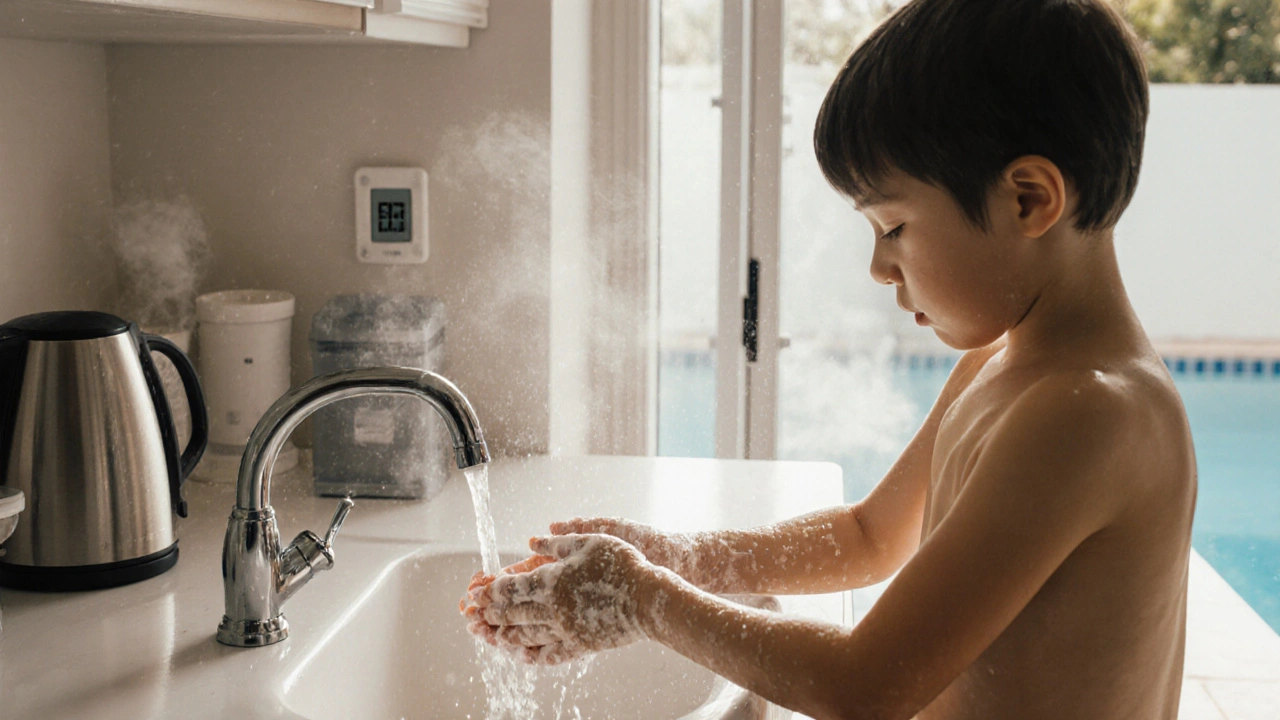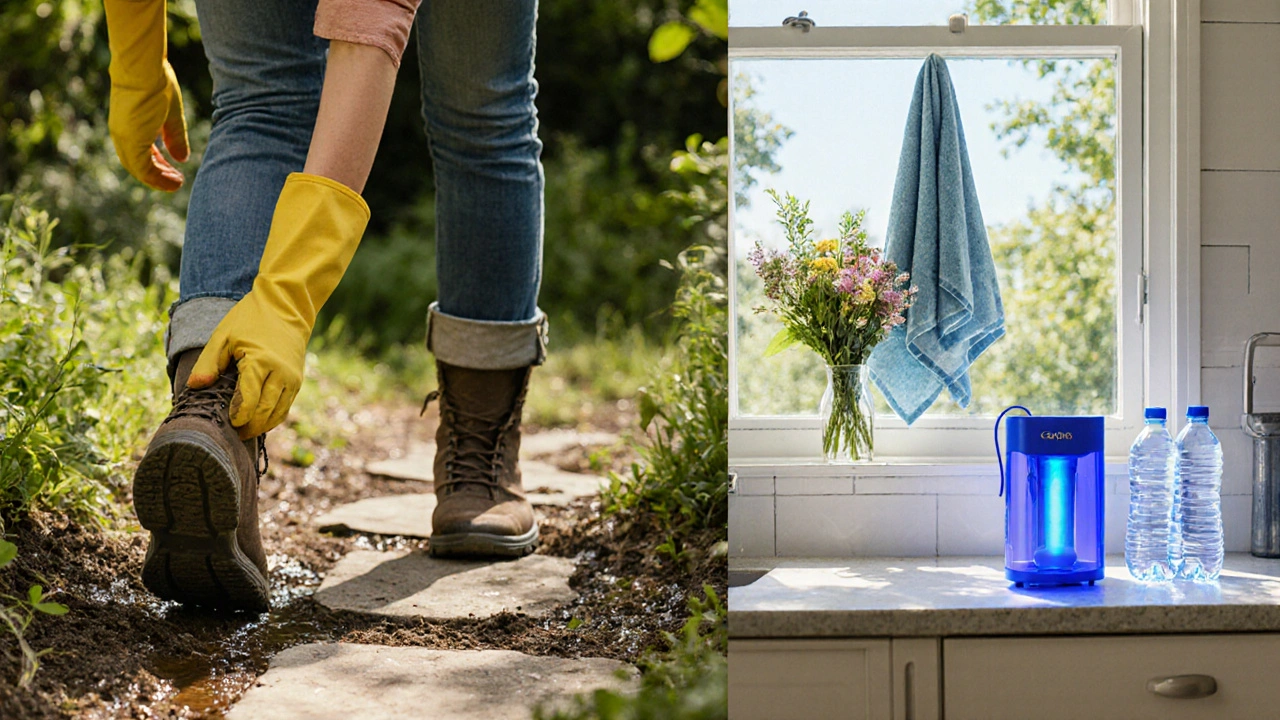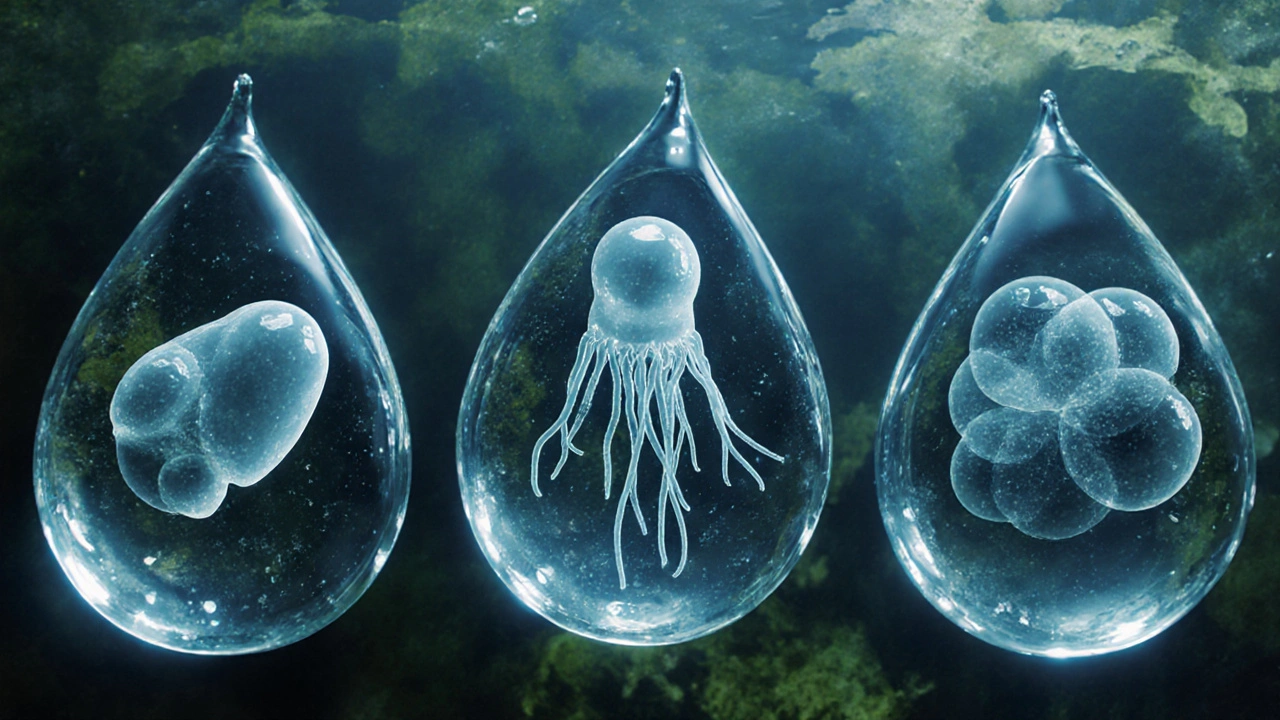Amoeba Infection Risk Assessment
| Frequency | Action | Why It Helps |
|---|---|---|
| Every time | Wash hands with soap after toilet, before eating, and after handling soil or raw fish | Removes cysts before they enter mouth or wounds |
| Before meals | Boil or filter drinking water if supply is uncertain | Destroys trophozoites and cysts |
| After swimming | Shower and rinse eyes with sterile saline if you wear lenses | Flush out any lingering organisms |
| Weekly | Test pool chlorine and pH levels | Maintains lethal environment for free-living amoebae |
| Weekly | Clean kitchen surfaces with a 5% bleach solution | Disinfects surfaces that may hold cysts |
| Monthly | Replace water filter cartridges according to manufacturer schedule | Ensures filtration efficiency stays high |
When it comes to amoeba infections are illnesses caused by microscopic protozoa that can invade the gut, eyes, brain, or skin. These tiny organisms thrive in dirty water, soil, and even poorly maintained swimming pools. If you’ve ever wondered why a single bout of bad hygiene can lead to a serious health scare, you’re in the right place. Below you’ll find the facts, the fixes, and a practical checklist to keep you and your family safe.
Key Takeaways
- Most serious amoeba infections are linked to contaminated water or inadequate hygiene.
- Three species cause the bulk of human disease: Entamoeba histolytica, Naegleria fowleri, and Acanthamoeba spp..
- Simple steps-clean drinking water, regular pool chlorination, hand‑washing after soil contact-slash infection risk by up to 80%.
- Immunocompromised people need extra vigilance; a boiled‑water habit can be lifesaving.
- Keep a daily hygiene checklist handy and review it each week.
How Amoeba Infections Spread
Understanding the route of entry makes prevention intuitive. Below is a quick rundown of the three big culprits.
- Entamoeba histolytica - lives in fecally‑contaminated water and food. It invades the colon, causing dysentery and, in severe cases, liver abscesses.
- Naegleria fowleri - the “brain‑eating” amoeba. It thrives in warm freshwater (think lakes, hot tubs). When water splashes up the nose, it can travel to the brain within hours.
- Acanthamoeba spp. - loves soil, tap water, and contact‑lens solutions. It can cause painful eye infections (Acanthamoeba keratitis) or skin lesions.
All three share a common weakness: they love environments where sanitation lapses and personal hygiene is ignored.

Why Sanitation Matters
Sanitation isn’t just about big‑scale sewage systems; it’s also the small, everyday actions that keep water and surfaces clean.
- Water treatment - Proper filtration and chlorination kill >99% of cysts and trophozoites. Even a simple home‑brew UV purifier can neutralise Entamoeba histolytica cysts.
- Surface cleaning - Disinfecting kitchen counters and bathroom fixtures with bleach (5% solution) removes lingering amoebic cysts that can cling to wet surfaces.
- Waste management - Prompt removal of human waste and correct latrine usage prevent environmental contamination that fuels the lifecycle of many amoebae.
In places where these basics slip, outbreaks spike. A 2022 study in Bangladesh linked a 12% rise in dysentery cases to the seasonal failure of a municipal water filtration plant.
Hygiene Practices That Cut the Risk
Turning knowledge into habit is where the rubber meets the road. Here are the top practices, each backed by field data.
- Hand‑washing - Scrub with soap for at least 20seconds after using the toilet, handling soil, or cleaning fish. A 2021 field trial in rural Kenya showed a 68% drop in amoebic dysentery when hand‑washing stations were installed.
- Safe drinking water - Boil water for 1minute before consumption if the source is uncertain. For everyday use, a certified carbon‑copper filter removes >95% of Acanthamoeba spp. cysts.
- Contact lens care - Use only lens solutions that contain a disinfectant approved for Acanthamoeba. Never rinse lenses with tap water; the organism can hitch a ride into the eye.
- Recreational water safety - Keep pool chlorine between 1-3ppm and test weekly. For lakes and hot tubs, avoid submerging your head if the water feels unusually warm or stagnant.
- Footwear outdoors - Wear shoes when walking in soil, especially in areas known for high amoeba presence. Soil‑borne cysts can cling to bare feet and find their way in through tiny cuts.

Special Populations That Need Extra Care
While anyone can get sick, certain groups are more vulnerable.
- Immunocompromised patients - Those undergoing chemotherapy or living with HIV have a weaker defense against invasive amoebae. For them, bottled water or a home UV system is recommended.
- Children - Kids exploring ponds or playing with sand are at higher risk of accidental ingestion. Supervise water play and enforce hand‑washing before meals.
- Elderly - Age‑related decline in immune function means a simple eye infection can progress rapidly. Regular eye‑care checks for contact lens wearers are a must.
Practical Checklist: Daily & Weekly Actions
| Frequency | Action | Why It Helps |
|---|---|---|
| Every time | Wash hands with soap after toilet, before eating, and after handling soil or raw fish | Removes cysts before they enter mouth or wounds |
| Before meals | Boil or filter drinking water if supply is uncertain | Destroys trophozoites and cysts |
| After swimming | Shower and rinse eyes with sterile saline if you wear lenses | Flush out any lingering organisms |
| Weekly | Test pool chlorine and pH levels | Maintains lethal environment for free‑living amoebae |
| Weekly | Clean kitchen surfaces with a 5% bleach solution | Disinfects surfaces that may hold cysts |
| Monthly | Replace water filter cartridges according to manufacturer schedule | Ensures filtration efficiency stays high |
Frequently Asked Questions
What are the most common symptoms of amoeba infections?
Symptoms vary by species. Entamoeba histolytica typically causes abdominal pain, diarrhea with blood, and fever. Naegleria fowleri leads to a rapid onset of severe headache, fever, nausea, and altered mental status within a few days of exposure. Acanthamoeba infections of the eye cause red, painful eyes, blurred vision, and a halo around lights.
Can boiling water kill all types of amoebae?
Yes. Boiling water for at least one minute inactivates cysts of Entamoeba histolytica, Naegleria fowleri, and Acanthamoeba spp.. It’s a simple, low‑cost method for households without advanced filtration.
Is swimming in chlorinated pools safe?
Properly chlorinated pools (1-3ppm) are generally safe because chlorine kills free‑living amoebae quickly. The risk spikes when chlorine drops below 0.5ppm or when pool water is warm and stagnant. Regular testing and shock treatments keep the environment hostile to these organisms.
How can I protect my contact lenses from Acanthamoeba?
Never rinse lenses or cases with tap water. Use only disinfecting solutions that explicitly list Acanthamoeba efficacy. Replace lens cases every three months and clean them with fresh solution each day.
What should I do if I suspect an infection?
Seek medical attention promptly. Early diagnosis-usually via stool microscopy for Entamoeba histolytica or CSF analysis for Naegleria fowleri-allows effective treatment with metronidazole or amphotericin B, respectively. Timely care can be the difference between recovery and severe complications.

Reynolds Boone
October 7, 2025 AT 13:08I grew up near a lake that was notorious for algae blooms and the occasional warning about “brain‑eating” amoebas. My family started boiling water before any drinking, even when the tap looked clear, and we never swam without a waterproof nose clip. The simple habit of washing hands after gardening kept my kids from picking up soil‑borne cysts. Those small steps added up, and we haven’t seen a single case of amoebic infection in our household.
Angelina Wong
October 23, 2025 AT 05:33Boiling water for a minute is a cheap and reliable way to kill amoebic cysts.
Anthony Burchell
November 8, 2025 AT 02:32You don’t need to live like a germ‑phobe; just clean the pool and wash your hands and you’ll be fine.
Michelle Thibodeau
November 28, 2025 AT 06:09I totally agree that hygiene is the first line of defense, but let me paint a broader picture. Imagine a world where every community has reliable water treatment, where schools teach kids to scrub their hands for a full twenty seconds, and where public pools are routinely shocked and monitored. In such a setting, the prevalence of amoebic dysentery would plummet, freeing up resources for other health priorities. The ripple effect extends beyond just personal safety; clean water reduces the burden of many diarrheal diseases that strain low‑income health systems. Moreover, consistent hand‑washing practices can curb the spread of respiratory viruses, something we’ve all learned is critical in pandemic times. It’s fascinating how a single habit can intersect with multiple layers of public health. When you pair hand hygiene with proper lens care-never rinsing contacts with tap water-you protect a vulnerable niche for Acanthamoeba. The same logic applies to footwear: simple rubber shoes prevent soil‑borne cysts from entering tiny cuts on the feet, especially for children who love to dig. Even the act of regularly testing pool chlorine levels seems mundane, yet it creates an environment hostile to free‑living amoebae, effectively turning a potential threat into a harmless recreation spot. The checklist in the article is a practical roadmap, but the real magic happens when these steps become cultural norms. Community leaders can champion weekly “clean‑water days,” reinforcing the message through local events. And for the immunocompromised, the stakes are even higher-access to filtered or bottled water can be a literal lifesaver. In short, sanitation and hygiene are not just personal responsibilities; they are pillars of collective resilience that ripple through families, schools, and entire societies.
Patrick Fithen
December 9, 2025 AT 16:56Think of an amoeba as a tiny opportunist; it exploits every lapse in our daily rituals. When you skip that quick rinse after handling soil, you hand it a free ride into your mouth or a cut. The same principle holds for water; a single unboiled sip can carry dormant cysts. Over time, these minuscule encounters accumulate into a public‑health burden that we could easily prevent.